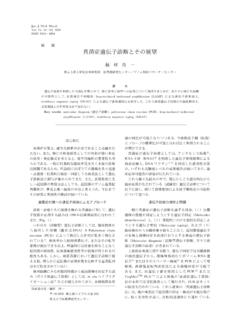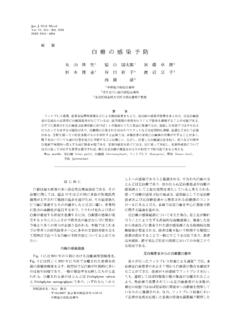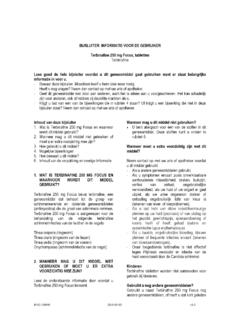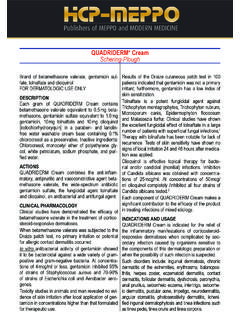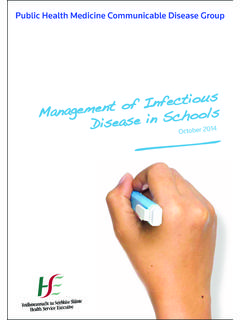Transcription of 皮膚真菌症と環境 - jsmm.org
1 Jpn. J. Med. Mycol. Vol. 47, 63 67, 2006. ISSN 0916 4804.. , , , , .. , , . , .. Trichophyton tonsurans .. T. rubrum T. mentagrophytes , . , , . , T. mentagrophytes 3 , , . , , , . , . T. rubrum , . T. mentagrophytes . , , . Candida albicans . Key words: dermatomycosis , environment , root of infection , anthropophilic , tinea pedis .. , . 1 .. , .. , , 80 . , Trichophyton tonsurans . , , . 3 .. , . 2 .. , , . , 1 .. , , .. , Table 1 . 27 . C 35 C , 95 100 , . , , , 95 , Arthroderma benhamiae . , . , . Microsporum , gypseum , , , . , , . 2, 3 3 . , 35 C .. 100 , 16 , 8 T. rubrum, T. mentagrophytes, T. tonsurans, T. violaceum, 90 , 80 Epidermophyton floccosum .. T. tonsurans.
2 332-8558 5-11-5 . E. floccosum . , 4 , 5 . 64 47 2 18 . Table 1. Infection mechanism and root of cutaneous mycosis I Internal cause 2 Outdoor 1 Candidosis Dermatophytosis Microsporum gypseum . 2 Tinea versicolor Sporotrichosis Sporothrix schenckii . Chromomycosis Fonsecaea pedrosoi II External cause Cryptococcosis Cryptococcus neoformans . 1 Animal Aspergillosis Aspergillus spp.. Dermatophytosis 3 Indoor Microsporum canis cat, dog Dermatophytosis Trichophyton verrucosum cattle Trichophyton rubrum Trichophyton mentagrophytes Trichophyton mentagrophytes Arthroderma benhamiae Trichophyton tonsurans rabbit, guinea pig, dog Trichophyton violaceum Cryptococcosis Epidermophyton floccosum Cryptococcus neoformans pigeon Tinea nigra Aspergillosis , Table 2.
3 Infection root of tinea pedis . Dissemination from tinea pedis patients , . Exist in the house interior . 6 , . mat, slipper, floor, house dust . , . Hortaea werneckii . Adherent to normal feet .. Infection (tinea pedis). , . , . , , , 12 . , , , , , . , . , , , , . 4 .. T. 13 . rubrum T. mentagrophytes , .. , , , , , . , .. Table 2 . T. mentagrophytes , 1, . 2 , 3 . , 14 . , . Tanaka 15 , .. , , , .. , , . , . 7 11 .. , . , .. , , . Table 3. The preventive effects of antifungal ointment Feet with Number of Feet without Number of Application time application colonies application colonies Just after 0 8 0 8 8 Just before 0 8 0 8 8 Before 1 hour 3 6 6 6 Before 3 hours 3 6 6 6 Before 3 hours 3 6 6 6 Washing just before Change from literature 16.
4 Jpn. J. Med. Mycol. Vol. 47 No. 2 , 2006 65. Table 4. Isolation from toe webs by the finger-sampling method Subject Clinical symptoms Direct examination Number of positive results 83/107 78 . Infected feet 17/42 41 . Not tested 30/115 26 . 2/11 18 . Non-infected feet Not tested 8/125 6 . Change from literature 19. Table 5. Results of taste disorder of candidosis of tongue and healthy volunteers Subject Taste disorder Mild Moderate Severe Candidosis of tongue 15/16 5 6 4. age 8 92 94 33 40 27 . Healthy volunteers 69/194 56 12 1. age 20 60 36 81 17 1 . 23/32 16 7 0. Carriers 72 70 30 . 46/162 40 5 1. Non-carriers 28 87 11 2 . Change from literature 20. 16 , , T. rubrum .. , . , T.
5 Mentagrophytes , .. , .. 6 . , , 1 , 3 , 3 .. , , . , , , . , , 1 3 , .. , 3 .. , , , , . Table 3 .. , , . 5 .. Sano 19 2 , , .. T. rubrum , Finger-sampling . T. mentagrophytes .. 17 , , . T. rubrum T. mentagrophytes , . , T. mentagrophytes 10 Table 4 . , T. rubrum , T. mentagrophytes .. , , . 18 .. , Sakashita 20 21 , . , T. rubrum , , . , T. mentagrophytes , Candida albicans . , T. rubrum .. 94 , , , . , . T. mentagrophytes , T. mentagrophytes 72 28 . , T. rubrum , T. Table 5 . , . mentagrophytes . T. rubrum , . 66 47 2 18 . , . 12 , , , , . , . 115: 1 , , 1315 1319, 2005. 41 5 9 2000. 13 , , , , , . 2 , , , . 44 269 271 2003. , . 44 Suppl 3 , , , 1 : 99, 2003. 45: 247 252 14.
6 2004.. 4 , , , , . 44 Suppl 1 : 98, 2003. Epidermophyton floccosum 15 Tanaka K, Katoh T, Irimajiri J, Taniguchi H, Yokozeki 7 45 Suppl 1 : 82 2004. H: The preventive effects of various footwear and 5 , , , , , cleaning methods on dermatophyte adhesion . , Epidermophyton floccosum 16 , , , , . 1 46: 1349 1351 2004. , . 6 , , , , , . 114 1651 1654 2004. , 17 , T. 29 147 151 2001. rubrum T. mentagrophytes . 7 Sugimoto R, Katoh T, Nishioka K: Isolation of Suppl 2 : 79, 2002. 43. dermatophytes from house dust on a medium 18 . containing gentamicin and flucytosine. Mycoses 38: 22: 680 683 2000. 405 410, 1995. 19 Sano T, Katoh T, Nishioka K: Culuring dermato- 8 Maruyama R, Katoh T, Nishioka K: Demonstration of phytes rapidly from each toe web by fingertrip J.
7 Dermatophyte dissemination from the infected soles Dermatol 32: 102 107 2005. using the foot-press method. Mycoses 41: 145 151, 20 Sakashita S, Takayama K, Nishioka K, Katoh T: 1998. Taste disorders in healthy carriers and non- 9 Watanabe K, Taniguchi H, Katoh T: Adhesion of carriers of Candida albicans and in patients with dermatophytes of healthy feet and its simple treatment. candidosis of the tongue J Dermatol 31: 890 897, Mycoses 43: 45 50, 2000. 2004. 10 22: 608 613, 21 , , , . 2000.. 11 . Derma 37: 9 14, 2000. Jpn. J. Med. Mycol. Vol. 47 No. 2 , 2006 67. Dermatomycosis and Environment Takuro Katoh Division of Dermatology, Saiseikai Kawaguchi General Hospital 5-11-5 Nishikawaguchi, Kawaguchi, Saitama 332-8558, Japan Environments may act as reservoirs for pathogenic fungi, a determinant of the establishment of fungal infection, or an exacerbating factor of disease.
8 In recent years, skin disease caused by geophilic fungi has been decreasing, while case reports of zoonoses from various animals are increasing. Outbreaks of anthropophilic T. tonsurans infection pose a problem to medical mycologists. Tinea pedis is the most common exogenous dermatomycosis in Japan. Although T. rubrum is presumed to be the dominant pathogen of this disease, T. mentagrophytes is detected more frequently from various environments, so far, the reason for this discrepancy has not been fully understood. The latest knowledge about the route of dermatophyte foot infection is as follows: 1 Dermatophyte propagules disseminated from patients may contaminate not only bath-mats but also wood floors, Japanese style mattings, concrete floors, slippers, cushions, etc.
9 , and from them adhere to healthy skin. 2 The agar stamping method can easily detect dermatophytes from the skin and the environment. 3 Propagules of T. mentagrophytes can survive for more than three months under certain conditions such as in rubber boots. 4 In order to eliminate dermatophytes gathered in socks and footwear, simple procedures washing, bathing with hot water, or wiping with a towel are all effective. 5 Prior application of an antifungal agent promptly eradicates dermatophyte propagules adhering to the skin from the environment. The author also mentioned the possibility of asymptomatic dermatophyte colonization, and the high prevalence of dysgeucia in oral carriers of Candida albicans.
10 , 49 3.

